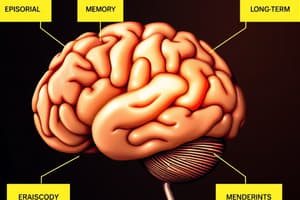Podcast
Questions and Answers
What is the primary function of output units in a PDP model?
What is the primary function of output units in a PDP model?
- Simulate human neural networks
- Process perceptual judgments
- Deliver responses based on judgments (correct)
- Receive signals from the retina
What is one main hypothesis tested by PDP models regarding human cognitive tasks?
What is one main hypothesis tested by PDP models regarding human cognitive tasks?
- PDP models can behave similarly to humans in specific tasks (correct)
- The PDP model replicates brain functions precisely
- Humans are unable to recognize objects
- Neurons do not affect perceptual judgments
What aspect do PDP models help to explore in relation to neurological damage?
What aspect do PDP models help to explore in relation to neurological damage?
- The physical structure of neurons post-damage
- Variations in tasks performed by undamaged brains
- Patterns of deficits in damaged models compared to humans (correct)
- The exact neural pathways affected by injury
What is indicated by a PDP model being able to accomplish a designated task?
What is indicated by a PDP model being able to accomplish a designated task?
How do PDP models relate to the concept of interconnected neurons?
How do PDP models relate to the concept of interconnected neurons?
What assumption underlies the comparison of neural activation during novel versus familiar stimuli in long-term memory studies?
What assumption underlies the comparison of neural activation during novel versus familiar stimuli in long-term memory studies?
Which aspect of memory is specifically focused on in the encoding versus recollection hypothesis presented by Tulving et al.?
Which aspect of memory is specifically focused on in the encoding versus recollection hypothesis presented by Tulving et al.?
What problem is identified in devising a condition for studying encoding in memory research?
What problem is identified in devising a condition for studying encoding in memory research?
In the study of fMRI data related to long-term memory, how might participants react differently to faces versus houses?
In the study of fMRI data related to long-term memory, how might participants react differently to faces versus houses?
What distinguishes encoding from recollection in the context of long-term memory studies?
What distinguishes encoding from recollection in the context of long-term memory studies?
Flashcards are hidden until you start studying
Study Notes
Imaging Long-Term Memory
- An approach to study LTM compares neural activation during the presentation of novel stimuli with the same during familiar stimuli.
- Stimulus novelty likely results in more robust encoding mechanisms being automatically recruited.
- The research focuses on encoding, not recollection.
Tulving et al. (1994)
- Researchers used a paradigm of presenting novel and familiar stimuli to study encoding in LTM.
- They were interested in whether encoding processes differed between novel and familiar stimuli.
- The experiment used a paradigm to test encoding process, but the researchers did not specifically probe recollection.
PDP Models
- PDP models are built to test hypotheses and simulate human behavior during a particular task.
- PDP models can help answer the question, "Could a system based on interconnected neurons accomplish object recognition?"
- It tests whether PDP systems are able to accomplish certain tasks, and if so, whether this implies that the human brain operates similarly.
Modelling Recognition
- A PDP model was created to simulate human facial recognition judgments.
- The model was tested to see if it could match human behavior.
- This model demonstrates that even if a system can perform a task, it doesn't necessarily explain how humans do that task.
PDP Models: Testable Hypotheses
- PDP models can be used to test more specific hypotheses, such as the effects of simulated neurological damage on the system's output.
- PDP models can simulate neurological damage (e.g., stroke) to understand how it affects performance.
- Simulated neurological damage in a PDP model can produce errors that mimic those exhibited by patients with semantic dementia.
PDP Models: Graceful Degradation
- PDP models show graceful degradation, meaning selective damage to certain units doesn't necessarily result in a complete system breakdown.
- This is similar to how neurological damage in humans can have varying effects depending on the damage's extent.
- This contrasts with other kinds of systems where damage can result in complete failure (for example, damage to an AC adaptor).
PDP Models: Graceful Degradation: Conceptual Knowledge
- The model's graceful degradation contrasts with the hypothesis that knowledge is stored in specific neurons or groups of neurons, which would lead to more selective losses.
- The "selective-loss" hypothesis implies specific damage would lead to specific knowledge loss, but neurological damage often results in more generalized effects.
- However, some cases suggest specific behavioral consequences from neurological damage, such as visual agnosia that only affects musical instruments.
How PDP Models Represent Information
- PDP models challenge the idea that knowledge is stored in an "amodal" form, independent of sensory modalities.
- Instead, they suggest that meaning emerges from the interaction of all parts of the system, not specific locations.
- This is related to the Gestalt principle that "The whole is more than the sum of its parts."
Declarative Long-Term Memory: Chapter 11
- The text refers to Chapter 11 of a book on declarative long-term memory.
Imaging Long-Term Memory: Experimental Challenges
- Early work on long-term memory using imaging highlighted challenges in design and analysis.
- One challenge was using block designs, which were typical at the time, in the experiment.
Petersen et al. (1988)
- The study by Petersen et al. (1988) compared activation during word blocks with fixation blocks using subtractive logic.
- The study used a block design comparing activation during word blocks with fixation blocks.
- There are methodological issues with this study, such as unclear participant activity during fixation blocks.
Studying That Suits You
Use AI to generate personalized quizzes and flashcards to suit your learning preferences.




